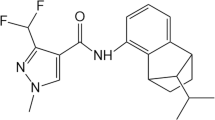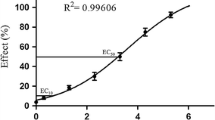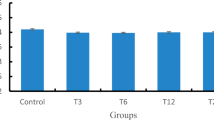Abstract
Propiconazole (PCZ) is a widely used fungicide around the world and was frequently detected in surface waters, which would pose risk to aquatic organisms. Previous studies indicated that PCZ has high toxicity to different kinds of fish. However, most of the studies focus on the toxicity and mechanisms of PCZ to adult fish, the potential toxicity mechanism of PCZ to fish embryos is still poorly understood. The present study investigated the effects of PCZ on content of reactive oxygen species (ROS) and malondialdehyde (MDA); activities of superoxide dismutase (SOD), catalase (CAT), and Na+-K+-ATPase; and expression level of genes related to oxidative stress, cell apoptosis, and innate immune system in zebrafish embryos after 96-h exposure. The results showed that 5.0 mg/L PCZ induced oxidative damage in zebrafish embryos, as indicated by increased ROS and MDA content and alteration of antioxidative enzyme activity. The activity of Na+-K+-ATPase in zebrafish embryos was significantly inhibited after exposure to 0.5 mg/L PCZ. The expression levels of bax, p53, casp-3, casp-9, and apaf-1 were significantly increased, indicating that cell apoptosis was caused in embryos by 5.0 mg/L PCZ. The expression level of interleukin-1b (IL-1b) and IL-8 increased after exposure to 0.5 mg/L PCZ, but that of IL-1b, IL-8, and cxcl-c1c (chemokine (C-X-C motif) ligand 18b) decreased in 5.0-mg/L PCZ treatment group, indicating an immunotoxicity effect. Our results suggest that oxidative damage, cell apoptosis, and immunotoxicity would be induced in zebrafish embryos after short-term exposure to PCZ.




Similar content being viewed by others
References
Acehan D, Jiang XJ, Morgan DG, Heuser JE, Wang XD, Akey CW (2002) Three-dimensional structure of the apoptosome: implications for assembly, pro-caspase-9 binding, and activation. Mol Cell 9:423–432
Ahrens L, Daneshvar A, Lau AE, Kreuger J (2018) Concentrations, fluxes and field calibration of passive water samplers for pesticides and hazard-based risk assessment. Sci Total Environ 637:835–843
Blasiole B, Canfield VA, Vollrath MA, Huss D, Mohideen MAPK, Dickman JD, Cheng KC, Fekete DM, Levenson R (2006) Separate Na+-K+-ATPase genes are required for otolith formation and semicircular canal development in zebrafish. Dev Biol 294:148–160
Bykov VJN, Wiman KG (2003) Novel cancer therapy by reactivation of the p53 apoptosis pathway. Ann Med 35:458–465
Cao F, Zhu L, Li H, Yu S, Wang C, Qiu L (2016) Reproductive toxicity of azoxystrobin to adult zebrafish (Danio rerio). Environ Pollut 219:1109–1121
Cao ZG, Zou LF, Wang HL, Zhang H, Liao XJ, Xiao JH, Zhang SH, Lu HQ (2019) Exposure to diclofop-methyl induces immunotoxicity and behavioral abnormalities in zebrafish embryos. Aquat Toxicol 214
Castillo LE, Ruepert C, Solis E (2009) pesticide residues in the aquatic environment of banana plantation areas in the North Atlantic zone of Costa Rica. Environ Toxicol Chem 19:1942–1950
Chau NDG, Sebesvari Z, Amelung W, Renaud FG (2015) Pesticide pollution of multiple drinking water sources in the Mekong Delta, Vietnam: evidence from two provinces. Environ Sci Pollut Res 22:9042–9058
Chu S-H, Liao P-H, Chen P-J (2016) Developmental exposures to an azole fungicide triadimenol at environmentally relevant concentrations cause reproductive dysfunction in females of medaka fish. Chemosphere 152:181–189
Deng J, Yu L, Liu C, Yu K, Shi X, Yeung LWY, Lam PKS, Wu RSS, Zhou B (2009) Hexabromocyclododecane-induced developmental toxicity and apoptosis in zebrafish embryos. Aquat Toxicol 93(1):29–36
Edwards PG, Murphy TM, Lydy MJ (2016) Fate and transport of agriculturally applied fungicidal compounds, azoxystrobin and propiconazole. Chemosphere 146:450–457
Egaas E, Sandvik M, Fjeld E, Källqvist T, Goksøyr A, Svensen A (1999) Some effects of the fungicide propiconazole on cytochrome P450 and glutathione S-transferase in brown trout (Salmo trutta). Comp Biochem Physiol C: Pharmacol Toxicol Endocrinol 122:337–344
Ferraro E, Corvaro M, Cecconi F (2003) Physiological and pathological roles of Apaf1 and the apoptosome. J Cell Mol Med 7:21–34
Glanemann C, Loos A, Gorret N, Willis LB, O'Brien XM, Lessard PA, Sinskey AJ (2003) Disparity between changes in mRNA abundance and enzyme activity in Corynebacterium glutamicum: implications for DNA microarray analysis. Appl Microbiol Biotechnol 61:61–68
Hu MH, Korschelt K, Daniel P, Landfester K, Tremel W, Bannwarth MB (2017) Fibrous nanozyme dressings with catalase-like activity for H2O2 reduction to promote wound healing. ACS Appl Mater Interfaces 9:38024–38031
Huang A-G, Tu X, Liu L, Wang G-X, Ling F (2016) The oxidative stress response of myclobutanil and cyproconazole on Tetrahymena thermophila. Environ Toxicol Pharmacol 41:211–218
ISO (1996) Water quality-determination of the acute lethal toxicity of substances toa freshwater fish [Brachydanio rerio Hamiltone-Buchanan (Teleostei,Cyprinidae)]. In: Part 3: Flow-through Method
Jiang J, Chen Y, Yu R, Zhao X, Wang Q, Cai L (2016) Pretilachlor has the potential to induce endocrine disruption, oxidative stress, apoptosis and immunotoxicity during zebrafish embryo development. Environ Toxicol Pharmacol 42:125–134
Jiang J, Shi Y, Yu R, Chen L, Zhao X (2018) Biological response of zebrafish after short-term exposure to azoxystrobin. Chemosphere 202:56–64
Jin Y, Pan X, Cao L, Ma B, Fu Z (2013) Embryonic exposure to cis-bifenthrin enantioselectively induces the transcription of genes related to oxidative stress, apoptosis and immunotoxicity in zebrafish (Danio rerio). Fish Shellfish Immunol 34:717–723
Kahle M, Buerge IJ, Hauser A, Müller MD, Poiger T (2008) Azole fungicides: occurrence and fate in wastewater and surface waters. Environ Sci Technol 42:7193–7200
Kaplan JH (2002) Biochemistry of Na,K-ATPase. Annu Rev Biochem 71:511–535
Konwick BJ, Garrison AW, Avants JK, Fisk AT (2006) Bioaccumulation and biotransformation of chiral triazole fungicides in rainbow trout (Oncorhynchus mykiss). Aquat Toxicol 80:372–381
Korsmeyer SJ, Yin X-M, Oltvai ZN, Veis-Novack DJ, Linette GP (1995) Reactive oxygen species and the regulation of cell death by the Bcl-2 gene family. BBA - Mol Bas Dis 1271:63–66
Kumar N, Awoyemi O, Willis A, Schmitt C, Ramalingam L, Moustaid-Moussa N, Crago J (2019) Comparative lipid peroxidation and apoptosis in embryo-larval zebrafish exposed to 3 azole fungicides, tebuconazole, propiconazole, and myclobutanil, at environmentally relevant concentrations. Environ Toxicol Chem 38:1455–1466
Li Z-H, Zlabek V, Grabic R, Li P, Machova J, Velisek J, Randak T (2010) Effects of exposure to sublethal propiconazole on the antioxidant defense system and Na+-K+-ATPase activity in brain of rainbow trout, Oncorhynchus mykiss. Aquat Toxicol 98:297–303
Li ZH, Zlabek V, Grabic R, Li P, Randak T (2011) Biochemical responses in gills of rainbow trout exposed to propiconazole. Cent Eur J Biol 6:84–90
Li ZH, Zlabek V, Velisek J, Grabic R, Machova J, Kolarova J, Li P, Randak T (2013) Multiple biomarkers responses in juvenile rainbow trout, Oncorhynchus mykiss, after acute exposure to a fungicide propiconazole. Environ Toxicol 28:119–126
Li H, Cao F, Zhao F, Yang Y, Teng M, Wang C, Qiu L (2018a) Developmental toxicity, oxidative stress and immunotoxicity induced by three strobilurins (pyraclostrobin, trifloxystrobin and picoxystrobin) in zebrafish embryos. Chemosphere 207:781–790
Li H, Yu S, Cao FJ, Wang CJ, Zheng MQ, Li XF, Qiu LH (2018b) Developmental toxicity and potential mechanisms of pyraoxystrobin to zebrafish (Danio rerio). Ecotoxicol Environ Saf 151:1–9
Livak KJ, Schmittgen TD (2001) Analysis of relative gene expression data using real-time quantitative PCR and the 2(T)(−Delta Delta C) method. Methods 25:402–408
Lushchak VI (2016) Contaminant-induced oxidative stress in fish: a mechanistic approach. Fish Physiol Biochem 42:711–747
Magnadóttir B (2006) Innate immunity of fish (overview). Fish Shellfish Immunol 20:137–151
Mobasheri A, Avila J, Cózar-Castellano I, Brownleader MD, Trevan M, Francis MJO, Lamb JF, Martín-Vasallo P (2000) Na+-K+-ATPase isozyme diversity; comparative biochemistry and physiological implications of novel functional interactions. Biosci Rep 20:51–91
Mu XY, Chai TT, Wang K, Zhu LZ, Huang Y, Shen GM, Li YR, Li XF, Wang CJ (2016) The developmental effect of difenoconazole on zebrafish embryos: a mechanism research. Environ Pollut 212:18–26
Nam YK, Cho YS, Choi BN, Kim KH, Kim SK, Kim DS (2005) Alteration of antioxidant enzymes at the mRNA level during short-term starvation of rockbream Oplegnathus fasciatus. Fish Sci 71:1385–1387
Ng CF, Schafer FQ, Buettner GR, Rodgers VGJ (2007) The rate of cellular hydrogen peroxide removal shows dependency on GSH: mathematical insight into in vivo H2O2 and GPx concentrations. Free Radic Res 41:1201–1211
OECD (2013) OECD guidelines for the testing of chemicals, fish embryo acute toxicity (FET) test. Organization for Economic Cooperation and Development, Paris
Pfeffer CM, Singh ATK (2018) Apoptosis: a target for anticancer therapy. Int J Mol Sci 19
Redza-Dutordoir M, Averill-Bates DA (2016) Activation of apoptosis signalling pathways by reactive oxygen species. BBA - Mol Cell Res 1863:2977–2992
Rodriguez J, Lazebnik Y (1999) Caspase-9 and APAF-1 form an active holoenzyme. Genes Dev 13:3179–3184
Rodriguez C, Mayo JC, Sainz RM, Antolin I, Herrera F, Martin V, Reiter RJ (2004) Regulation of antioxidant enzymes: a significant role for melatonin. J Pineal Res 36:1–9
Savan R, Sakai M (2006) Genomics of fish cytokines. Comp Biochem Physiol D: Genomics and Proteomics 1:89–101
Schieber M, Chandel Navdeep S (2014) ROS function in redox signaling and oxidative stress. Curr Biol 24:R453–R462
Shah PT, Martin R, Yan Y, Shapiro JI, Liu J (2016) Carbonylation modification regulates Na/K-ATPase signaling and salt sensitivity: a review and a hypothesis. Front Physiol 7:256
Shu XD, Cheng KR, Patel N, Chen FH, Joseph E, Tsai HJ, Chen JN (2003) Na,K-ATPase is essential for embryonic heart development in the zebrafish. Development 130:6165–6173
Singh PSA (2014) Behavioral changes by inhibition of acetylcholinesterase induced by Trizole (propiconazole) fungicide on freshwater fish Clarias batrachus. World J Fish Mar Sci 6:82–86
Sinha K, Das J, Pal PB, Sil PC (2013) Oxidative stress: the mitochondria-dependent and mitochondria-independent pathways of apoptosis. Arch Toxicol 87:1157–1180
Skolness SY, Blanksma CA, Cavallin JE, Churchill JJ, Durhan EJ, Jensen KM, Johnson RD, Kahl MD, Makynen EA, Villeneuve DL, Ankley GT (2013) Propiconazole inhibits steroidogenesis and reproduction in the fathead minnow (Pimephales promelas). Toxicol Sci 132:284–297
Souders CL, Xavier P, Perez-Rodriguez V, Ector N, Zhang J-L, Martyniuk CJ (2019) Sub-lethal effects of the triazole fungicide propiconazole on zebrafish (Danio rerio) development, oxidative respiration, and larval locomotor activity. Neurotoxicol Teratol 74:106809
Steinke JW, Borish L (2006) 3. Cytokines and chemokines. J Allergy Clin Immunol 117:S441–S445
Tabassum H, Khan J, Salman M, Raisuddin S, Parvez S (2016) Propiconazole induced toxicological alterations in brain of freshwater fish Channa punctata Bloch. Ecol Indic 62:242–248
Teng M, Zhao F, Zhou Y, Yan S, Tian S, Yan J, Meng Z, Bi S, Wang C (2019) Effect of propiconazole on the lipid metabolism of Zebrafish embryos (Danio rerio). J Agric Food Chem 67:4623–4631
Tu T-Y, Hong C-Y, Sasado T, Kashiwada S, Chen P-J (2016) Early life exposure to a rodent carcinogen propiconazole fungicide induces oxidative stress and hepatocarcinogenesis in medaka fish. Aquat Toxicol 170:52–61
Valadas J, Mocelin R, Sachett A, Marcon M, Zanette RA, Dallegrave E, Herrmann AP, Piato A (2019) Propiconazole induces abnormal behavior and oxidative stress in zebrafish. Environ Sci Pollut Res 26:27808–27815
Velki M, Meyer-Alert H, Seiler TB, Hollert H (2017) Enzymatic activity and gene expression changes in zebrafish embryos and larvae exposed to pesticides diazinon and diuron. Aquat Toxicol 193:187–200
Walensky LD, Gavathiotis E (2011) BAX unleashed: the biochemical transformation of an inactive cytosolic monomer into a toxic mitochondrial pore. Trends Biochem Sci 36:642–652
Yin Y, Zhang P, Yue X, Du X, Li W, Yin Y, Yi C, Li Y (2018) Effect of sub-chronic exposure to lead (Pb) and Bacillus subtilis on Carassius auratus gibelio: bioaccumulation, antioxidant responses and immune responses. Ecotoxicol Environ Saf 161:755–762
Zhao F, Li H, Cao F, Chen X, Liang Y, Qiu L (2019) Short-term developmental toxicity and potential mechanisms of the herbicide metamifop to zebrafish (Danio rerio) embryos. Chemosphere 236:124590
Zheng J-L, Zeng L, Shen B, Xu M-Y, Zhu A-Y, Wu C-W (2016) Antioxidant defenses at transcriptional and enzymatic levels and gene expression of Nrf2-Keap1 signaling molecules in response to acute zinc exposure in the spleen of the large yellow croaker Pseudosciaena crocea. Fish Shellfish Immunol 52:1–8
Zhu B, Liu L, Gong Y-X, Ling F, Wang G-X (2014) Triazole-induced toxicity in developing rare minnow (Gobiocypris rarus) embryos. Environ Sci Pollut Res 21:13625–13635
Zhu L, Mu X, Wang K, Chai T, Yang Y, Qiu L, Wang C (2015) Cyhalofop-butyl has the potential to induce developmental toxicity, oxidative stress and apoptosis in early life stage of zebrafish (Danio rerio). Environ Pollut 203:40–49
Funding
This study was financially supported by The National Key Research and Development Program of China (2016YFD0201203).
Author information
Authors and Affiliations
Corresponding author
Additional information
Responsible Editor: Philippe Garrigues
Publisher’s note
Springer Nature remains neutral with regard to jurisdictional claims in published maps and institutional affiliations.
Rights and permissions
About this article
Cite this article
Zhao, F., Cao, F., Li, H. et al. The effects of a short-term exposure to propiconazole in zebrafish (Danio rerio) embryos. Environ Sci Pollut Res 27, 38212–38220 (2020). https://doi.org/10.1007/s11356-020-09968-7
Received:
Accepted:
Published:
Issue Date:
DOI: https://doi.org/10.1007/s11356-020-09968-7




